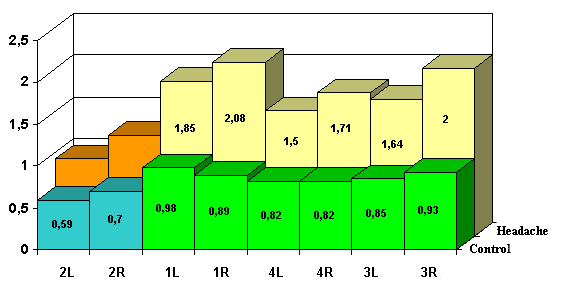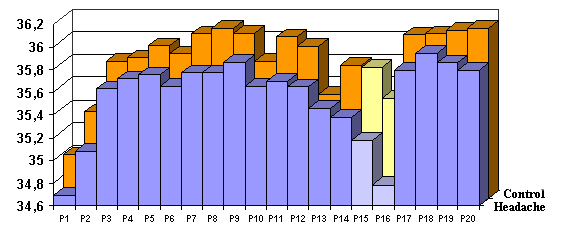
T.Yu. Gousseinov, S.G. Vesnin
Ref: Reports of Russian Scientific & Practical Conference “Clinical and Theoretical Aspects of Pain”, M., 2001, pp. 28-29.
For the last years the interest to noncentral mechanisms in headache development has occurred. The possibility of interaction between peripheric and central factors is worth paying attention not only for cervicogenic headache, but also for TTH, migraine and other types of headache. One of the important peripheric factors in headache is muscle disorders. However the role of these disorders in headache is only a speculation. Research progress in this direction is limited by the absence of the objective criteria, which could evaluate muscular impairments. The purpose of the investigation was evaluation of possibility to use microwave radiometry (RTM) to diagnose muscular - articular disorders of neck in patients with cervicogenic headache. In contrast to infrared thermography microwave radiometry receives thermoemission from tissue at depth of 3-5 cm.
Cervicogenic headache was diagnosed by Sjaastad criteria. Six patients had a diagnostic anaesthetic blockade of cervical nerves with following remission. The control group (48 patients) was health voluntaries.
RTM was performed by the RTM-01-RES radiometer of RES Ltd. The standard points (Fig.1) covered area of the craniocervical transition and the whole cervical area of the spine were measured.
|
|
Fig.1
After RTM the muscle tendernesses of the cranicervical area (fig.2) were assessed by palpation according to the 4-score scale (0 – no pain and visible reaction; report of tenderness without visible reaction; 2 - report of painful tenderness and visible reaction; 3 - report of severe pain and marked reaction) and the rotation of the head was measured with a goniometer at C1-C2 vertebrae level.
|
|
Fig.2
In patients with cervicogenic headache the tenderness in three paired points of four points was stronger than it was in the control group (p<0,01) (Fig.3). In the figure these points are light.
Fig. 3
 |
| Muscular tendernesses in the Control Group and in the patients with Cervicogenic Headache |
RTM for the craniocervical zone (points 3-9) did not detect any differentials between the groups (Fig.4).
Fig.4
 |
| RTM of Cervical Area in the Control Group and in the patients with Cervicogenic Headache |
In patients with cervicogenic headache in the cervicothoracic transition (light points 15-16) there was lower thermoemission compared to the control group (point 15 – 35.2+0.81°Ń and 35.8+0.64°Ń, p=0.015; point 16 –34.9+1.0°Ń and 35.5+0.77°Ń, p=0.022 respectively, represented as m+SD).
Correlation analysis between RTM data, muscular tenderness and rotation at C1-C2 level found out different correlations in the groups. In patients with cervicogenic headache there was positive correlation between the point of the mastoid process in the right (Point 2) and thermoemission at points 5,6,8,11,12 (p= 0.024; 0.03; 0.036; 0.03; 0.035 respectively), projection of the arch of atlas in the right (point 3) and points 4,11,12 (p= 0.032; 0.013; 0.024, respectively). Also there was a positive correlation between rotation asymmetry at C1 level and point 4 (p=0.015).
In the control group no correlation between points of muscle tenderness and thermoemission points has been revealed.
We suppose that RTM depicts a value which depends on the ratio between metabolic level and microcirculation of measured area. It can be connected to the pattern of vegetative innervation in this zone. In patients with cervicogenic headache thermoemission of cervicothoracic transition is lower than it is in the control group. It can be caused by chronic process accompanied by dystrophic changes. Also there was a correlation between RTM values of cervical area and muscular tenderness and rotation at C1-C2 vertebrae level. Thus RTM is promising for diagnosing muscular-articular disorders in patients with headache. However investigations of usage of RTM in diagnosis of cervical headache and muscular-articular disorders have to continue.